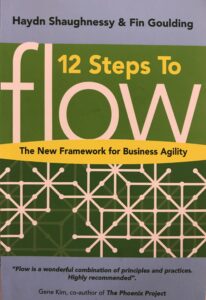Podcast: Play in new window | Download
Subscribe: RSS
This podcast covers Chapter 3, “Disrupting The Cadence of Work” of “12 Steps to Flow: The New Framework for Business  Agility,” by Haydn Shaughnessy and Fin Goulding, developers of the internationally acclaimed workshop, Flow Academy. Chapter 3 deviates markedly from the traditional Waterfall approach. A visual approach is used with Post-Its on the wall and no extensive, traditional documentation. All functionalities, including Finance, etc., are included. Communication is brief via Tweets, use of the phone, etc., to create energy in the team and avoid the stodginess of traditional approaches. Work is divided into 2 day chunks by applying CATE from Chapter 2:
Agility,” by Haydn Shaughnessy and Fin Goulding, developers of the internationally acclaimed workshop, Flow Academy. Chapter 3 deviates markedly from the traditional Waterfall approach. A visual approach is used with Post-Its on the wall and no extensive, traditional documentation. All functionalities, including Finance, etc., are included. Communication is brief via Tweets, use of the phone, etc., to create energy in the team and avoid the stodginess of traditional approaches. Work is divided into 2 day chunks by applying CATE from Chapter 2:
C = (dynamic) Customer segmentation
A = Asset discovery
T = Targeted ideation
E = Ecosystem
It’s all about reducing the cycle time to get product out. Move forward with successes and make changes as needed based on feedback.
To make this all happen a big part of senior management’s job is making sure the team feels safe and able to work iterations and apply lessons-learned.
By working interactively in short cycles work can be transferred to a Kanban board which supports continuous innovation because trust is present. This is superior to continuous improvements.
The “soft” skills senior management must practice can be quite hard. Working with human nature is not necessarily a straightforward task. It requires senior management to work as servant-leaders both supporting the team and watching that the team is going in the right direction.
Methodologies now come into play for continuous innovation. What is critical is methodologies are used in a flexible manner, picking the tool that works best in a situation.
The Minimal Sustainable Delivery Matrix (MSD) is introduced, which solves the problem incrementally with constant feedback from the customer. This is a method superior to MVP (minimal viable product). MSD requires critical non-essentials and marginal gains (see Chapter 1).
Kanban is preferred over Scrum because the team only takes on the work they can do. Those in Business Analysis can work on improving the backlog.
Also, by having the short intervals decreases the occurrence of context switching where team members are constantly switching back and forth between tasks.
The chapter concludes with a 12 step approach to reduce cycle time:
- smaller work units
- increased team interaction
- multidisciplines environment
- allowance for new tools, techniques, and workarounds
- shorter cycle times improves accuracy of budgeting
- visible work ( Post-Its on wall) shows dependencies
- visible work allows for better resource allocation
- collaborative thinking
- work breakdowns performed groups
- the value of work is visible
- cycle time for feedback is shortened
- faster pivots on short notice
Here are the link for:
episode 0037 of Wrestling with Chaos. the Introduction, The Value Seeking Enterprise, and Chapter 1, Talking About Business Agility:
episode 0042 of Wrestling With Chaos. For Chapter 2, The Customer In The Agile Business.
For more on the various “Walls” using Post-Its refer to their excellent book, “Flow.”
In line with Business Agility and dealing with complex situations, you can download CMC’s free e-book MINDSET – 5 SIMPLE WAYS TO LOOK AT COMPLEX PROBLEMS and learn how to find a simple vantage point from which you can resolve challenges.
Your feedback is important. Choose from the following options:
- place a review in iTunes,
- click on “leave a comment” below,
- send any comments along with your name and the show number to support@ctrchg.com
Listen to future episodes for our reply.


Recent Comments